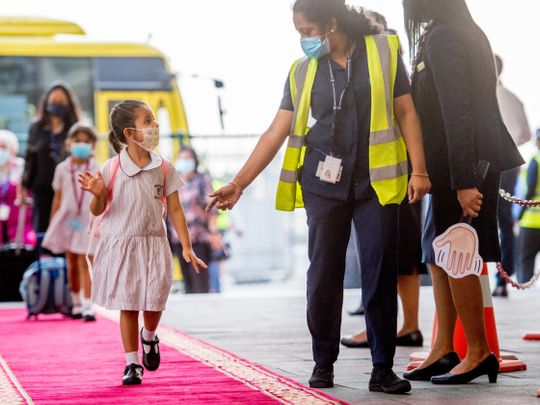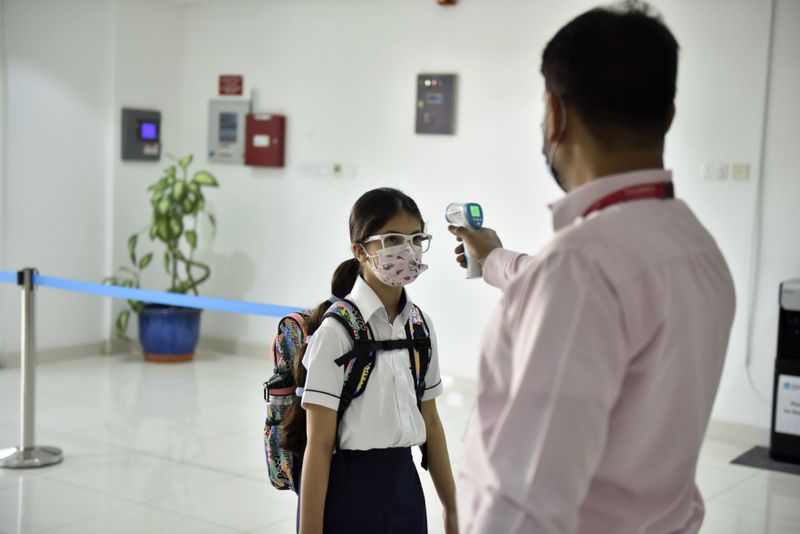
- Over a million students returned to schools across the UAE this week.
- Strict measures are in place to control the spread of COVID-19.
- Students have opted for both remote and in-class lessons.
- Students and experts discuss pros and cons of both steps.
- Ultimately, there is no substitute for in-class learning.
Abu Dhabi, Dubai: Welcoming students back to school after six months, the UAE has allowed families to choose between distance learning and classroom learning for the first time this term.
Faced with the option, a fair number of students did return to campuses this week. Others returned to learning through devices, even as the UAE mandated distance learning on Tuesday in other schools where students or staff had been suspected of being positive for COVID-19.
See more
In all, it has been a careful resumption of classes for over one million schoolchildren across the country, with authorities, parents and schools exerting every effort to ensure that learning can continue safely despite the COVID-19 outbreak.
While children have been happy to return to a semblance of routine and normality, they appear to have clear opinions on what they perceive as the benefits of each learning model.
Gulf News spoke to seven children, enrolled in different grades, after a week of learning in the new term to get their thoughts on the two disparate learning methods — distance learning vs in-class learning.
Grade 2 at Brighton College, Abu Dhabi
Lola Chalk, 7, British: Opted for in-class learning
I like:
“Being able to bring my own things to school and using them in my work.”
“Getting to see my friends again.”
I don’t like
“That I am not allowed to be close to my friends, and that we have to stay apart all the time.”
“Wearing masks; I can’t wait to take it off.”
Mason Sellers, 8, British: Opted for in-class learning
I like:
“The mindfulness colouring activities, they help me think and be calm.”
“Doing English and French with my teachers again.”
I don’t like:
“That we are not allowed on the field so I can’t play football with my friends, or do football teams with my friends.”
“Wearing masks.”
Mariam Al Khoori, 6, Emirati: Opted for distance learning
I like:
“Love doing Maths in distance learning because there are lots of things I can move around on the iPad to help me. We have had lots of base 10 equipment to help us on Seesaw.”
“Science has been fun because I’ve been able to show my own research to my teacher.”
I don’t like:
“Not being able to see my friends.
“That some English work is tricky when I can’t discuss it with my friends.”
Nicholas Bayley, 7 British: Opted for distance learning
I like
“Being able to do my schoolwork on my iPad.”
I don’t like:
“Not being able to go outside and play.”
“Seeing all my friends; I miss them.”
Grade 4 at Brighton College, Abu Dhabi
Malak Ali, 9 Egyptian: Opted for in-class learning
I like:
“Seeing my friends again.”
“Actually being in school, having to get up and come to school.”
I don’t like:
“Having to social distance all the time.”
“Only seeing some of my friends: we can only see the people in our bubble.”
Jason Afuwape, 9, British: Opted for in-class learning
I like:
“Getting to do my favourite subjects like English and Math with my teacher in class.”
“Seeing some of my friends.”
I don’t like:
“Not being allowed to play outside.”
“The longer lines and having to walk in specific directions when we can come out of our room.”
Camellia Rashad, 9 Ukrainian: Opted for distance learning
I like:
“Completing the learning at my own pace, and being able to rewind and re-watch video if I am unsure.”
“That the online lessons are also really fun!”
I don’t like:
“That there are so few challenges for math lessons!”
Grade 12 at the American Academy for Girls, Dubai
Alia Al Muhairi, Emirati: Opted for in-class learning
I like:
“The in-person interaction with peers and teachers”
“That there is no need to ‘adjust’ to the learning environment, as is the case with distance learning”
Pros of distance learning
“We were able to create such a strong connection as we were all going through the same things and we were all trying to help each other out.”
“e-learning has taught us to adjust to unexpected situations.”
Grade 7 at the American Academy for Girls, Dubai
Hamda Haji: Opted for in-class learning
I like:
“That I can understand my teachers better when they explain in person.”
“Getting to see our amazing friends and teachers.”
Shehzeen Hashmi, an alumni of American Academy for Girls, Dubai
Distance learning
Pros
1. Easy access to educational resources
2. Ability to access learning materials from home
3. Less risk of the virus spreading
4. Easier way to showcase online media/presentations
5. Encourages using new and innovative learning methods
Cons
1. Staring at a screen for long hours
2. Logging/connectivity issues
3. Difficulty in having group discussions/ collaborative work
4. Takes a toll on the development of social skills
5. Difficulty in asking for help from the teacher if the lesson is hard to understand.
In-class learning
Pros
1. Chance to meet friends/other students
2. Develop socially
3. Have group discussions and showcase teamwork
Cons
1. Risk of the virus spreading
2. Doing PE/having lunch is more difficult
3. Discomfort in wearing mask the whole day
Experts speak
Following last-term’s mandated distance learning, schools now have greater flexibility to decide what style of learning best suits students. Even as they do this however, experts agree that nothing can replace the experience of learning in a brick-and-mortar school.
Emma Whale, Vice President — Schools, Pearson Middle East, said now that the school lockdown, which had forced all learning online, is behind us, schools have more room to find “the optimum blend between face-to-face and remote learning, and to consider the advantages and disadvantages of both”.
Harvesting student data
She added that distance learning “if used correctly” allows teachers to “harvest thousands of data points about a learner which can then be used to help shape their learning journey more effectively”
“For example, the role that a teacher plays at our fully virtual school, Pearson Online Academy is often centred around analysing data to help guide learners’ next steps, more than ‘from-the-front’ instruction. And this is not just limited to data from assessments, but also data points around engagement, collaboration, time spent on group chats and so on,” Whale said.
Here to stay?
Despite schools reopening, it seems like some form of distance is here to stay.
The recently-conducted Global Learner Survey by Pearson shows that globally, 70 per cent of respondents agreed that primary and secondary learning will become more virtual 2020 onwards and 78 per cent agreed that online learning might lead to a more quality education experience in the future.
‘No match’ for real classroom
However, it cannot be a replacement for that “uniquely human skill set” built on collaboration, leadership, intra-personal skills, which require groups of learners to work together to build, Whale said.
“Some of that can of course be facilitated online, but it’s no match for a face-to-face classroom where learners get to interact with each other, share their life experiences, forge a personal connection and so on.”
Mike Wolfe, vice-principal at the British International School, Abu Dhabi, agreed.
“There is nothing like coming to school — a familiar place — and seeing one’s friends and teachers to dissipate any anxiety brought about by the COIVD-19 crisis, for instance. Settling into a familiar routine also contributes to children’s sense of well-being and adds a touch of normality, and this extends across children of different age groups,” he said.
Home learning ‘fatigue’
Whale said in the previous term, “We had feedback that parents were starting to narrow the curriculum diet as their children experienced ‘home learning fatigue’, focusing on making sure progress was being achieved in numeracy and literacy as a baseline but often abandoning other subject areas”.
Balanced curriculum
But schools are about a broad and balanced curriculum — hands-on practical experiences in the sciences, arts, technologies, as well as a place where learners develop wider extra-curricular interests, she added.
“The focus, energy and engagement that the school environment offers young people is critical as they shape their own sense of self,” Whale said.

Wolfe added that people have been living in front of screens for a number of months now. “I cannot explain just how much laughing happens during the day at school,” he said.
Youngest learners
“In addition, being in the classroom allows teachers to address learning gaps, pick up on children’s cues and body language and tailor teaching to each child. This is not as easy when teaching is conducted remotely,” Wolfe added.
As an extension, schools also provide a vital childcare role. “We also cannot underestimate this crucial role that schools play, particularly with the youngest learners, the majority of which will naturally find self-led learning across the length of a school day extremely difficult without the intervention of an adult who can act as a ‘learning coach’,” Whale said.
















